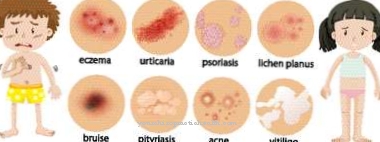A Thromboembolism causes blood clots in the veins, mostly in the legs. If these clumps loosen, they can lead to life-threatening constrictions of the blood vessels in the lungs.
What is thromboembolism?

A Thromboembolism is a condition that causes a blood clot in one or more veins in the body; mostly in the legs. The thromboembolism can cause pain in the legs, but usually also causes other symptoms.
The thromboembolism can be caused by staying in a single sitting or lying position for a long time, for example in a car or airplane. Or another disease that affects the clotting of the blood.
A thromboembolism is a serious illness. The clot that has formed in the veins can suddenly loosen and "shoot" through the bloodstream to the lungs; there it can then lead to dangerous constrictions of the blood flow.
causes
A Thromboembolism can be favored by many circumstances. This includes all factors that influence the coagulation of the blood. The contraction of the muscles promotes blood flow throughout the body.
On longer journeys, for example, the legs are often not moved for hours. The risk of a clot increases significantly here. People with increased coagulation are also more likely to develop a thromboembolism. Your predisposition only becomes a problem when other negative factors are added.
Long hospital stays, for example after an operation, also increase the risk. During pregnancy, the pressure on the leg veins increases, which also increases the risk. In people with heart problems, blood may no longer be pumped effectively through the veins, which can lead to lighter clumps.
The same applies to obesity, smoking and old age. The risk of thromboembolism increases significantly from 60.
Symptoms, ailments & signs
The symptoms of a thromboembolism depend on which organs are affected. Venous thromboembolisms usually cause pulmonary embolisms. Arterial thrombosis can lead to strokes, heart attacks, kidney infarctions, mesenteric infarctions (death of a section of the intestine) or splenic infarctions.
The most common consequences of thromboembolism are pulmonary embolism (venous thromboembolism) and strokes (arterial thromboembolism). The symptoms of pulmonary embolism can range from mild to very severe, depending on the size and location of the detached thrombi. Severe pulmonary embolism is often fatal. The first signs are usually shortness of breath and chest pain.
Furthermore, palpitations, cyanosis, dizziness, coughing and sweating are observed. With mild pulmonary embolisms, often only unspecific symptoms such as dizziness and a slight fever occur. Therefore, these are often not diagnosed. The most common arterial thromboembolism is a cerebral infarction (stroke). There are also different degrees of severity here.
Unilateral paralysis, speech disorders and limited speech comprehension are typical of severe strokes. Other symptoms include visual disturbances, clouding of consciousness, balance problems (dizziness, unsteady gait), nausea, headache and amnesia. In the case of kidney, spleen or mesenteric infarcts, the acute abdomen (colic-like abdominal pain) is initially in the foreground.
Kidney infarctions are also characterized by blood in the urine, partial urinary behavior and possibly fever. In the case of mesenteric infarction, after the initially severe colic has subsided, the symptoms temporarily improve. This phase is followed by a breakthrough of the intestine, which is accompanied by peritonitis, shock symptoms and an often fatal sepsis.
Diagnosis & course
During an examination, the doctor will ask the patient about their symptoms. This is followed by a physical exam to find any swollen or discolored areas on the skin that indicate a Thromboembolism Clues. Depending on the likelihood of a thromboembolism, the doctor may perform additional tests. These can include:
Ultrasonic: The device is applied to the critical areas of the body and, with the help of sound waves, can reproduce an image on a monitor, which gives the doctor a more precise idea of how the blood vessels are behaving.
Blood test: Most people with thromboembolism have high levels of clotting s substance in the blood. This can be proven by a blood test.
CT or MRI: These are technically complex imaging procedures that can give the doctor an even more precise picture of the affected veins.
Complications
Thromboembolism is a dangerous condition and can have very serious complications. If the patient has survived a thrombosis, a partially or even completely blocked vein is often left behind, which can lead to blood backlogging in the affected limbs. In the long term, the increased venous pressure often causes the development of varicose veins as well as swellings and skin changes on the lower leg, which can turn brown.
The formation of ulcers in the ankle area is also possible. These side effects are known as post-thrombotic syndrome and can affect the patient's quality of life. The risk of such a development also exists if a blood clot is slowly broken down by the body, but the sensitive venous valves are destroyed during this process.
In these cases, the blood flow back to the heart is only possible when lying down. In contrast, when sitting and especially when standing, the blood sinks back into the legs. Depending on how severe the venous valve damage is, the affected limbs regularly swell significantly during the day. Edema forms.
Such complications are to be expected especially if the patient does not take the thromboembolism seriously or if it is not treated properly by a doctor for other reasons. The worst complication that can be associated with deep vein thrombosis is pulmonary embolism. In this case, a sudden cardiac arrest with fatal consequences threatens.
When should you go to the doctor?
In the case of a thromboembolism, the person concerned depends on a medical examination and treatment to avoid further complications. Only through early detection of the symptoms can complete healing be guaranteed and the death of the person affected prevented. For this reason, a doctor should be consulted at the first signs of thromboembolism. The doctor should be consulted in this disease if the person concerned suffers from shortness of breath and severe heart problems. These symptoms usually come on very suddenly and do not go away on their own.
Most patients also experience severe chest pain or severely swollen legs. Should these symptoms occur, a doctor must be consulted in any case. This disease cannot heal itself. If the symptoms of a thromboembolism occur, an emergency doctor must be called or a hospital visited. The thromboembolism does not always have to lead to sudden symptoms. Chronic pain in the lungs or persistent heart problems can also indicate thromboembolism and should be examined by a cardiologist. This disease may reduce the life expectancy of the person affected.
Treatment & Therapy
Treating a Thromboembolism has three goals: to keep the blood clots from growing; prevent the clot from coming off; reduce the risk of further clots.
The following measures exist to achieve this: Blood thinners: These agents thin the blood, thereby reducing the ability to clot and thus also reducing the risk of clots. The first few doses are usually injected directly into the bloodstream. Therapy is then continued with special medication.
Thrombolytics: These drugs are used for more serious forms of thromboembolism. They are aimed directly at the dangerous clots and dissolve them in a targeted manner. The drugs can have severe side effects and are usually only used in life-threatening situations.
Filter: If medication cannot be used, it is possible to install a filter in the vein to keep ascending clots from entering the lungs.
prevention
One Thromboembolism preventing them is much easier than treating them. There is an increased risk after operations. Medication should be strictly adhered to, especially when it comes to blood thinners.
People who sit frequently and for long periods of time should exercise their calves and legs; this can also be done in small exercises during work. Apart from that, you should get up frequently and move a few meters. A healthy weight, a healthy diet and not smoking are also effective preventive measures.
Aftercare
In most cases, the affected person has very few or only limited options for follow-up care for thromboembolism, as it is a relatively rare disease. So that there are no other complications or complaints in the further course, those affected should consult a doctor at an early stage. A doctor should be contacted at the first signs or symptoms of the disease.
The treatment of thromboembolism is usually carried out by taking various medications, mainly antibiotics. In doing so, regular intake with the correct dosage must always be observed, whereby antibiotics should not be taken together with alcohol. Those affected should always observe the prescribed dosage and regular intake, whereby alcohol should be avoided during the cure.
In general, a healthy lifestyle with a healthy diet can have a very positive effect on the further course of the disease. No further follow-up measures are available to those affected by thromboembolism. In most cases, this disease also does not reduce the life expectancy of the person affected.
You can do that yourself
In the event of a thromboembolism, the necessary measures must be taken immediately to avoid a thrombosis. This includes active physiotherapy and the wearing of anti-thrombosis stockings or compression bandages. In addition, any coagulant medication such as estrogens must be discontinued in consultation with the doctor. The doctor will also rule out thrombophilia. Depending on the severity of the thromboembolism, these measures may already be sufficient to prevent thrombosis.
Comprehensive physiotherapy may be required for bedridden patients. It is also important to avoid arterial embolism. In addition to the administration of analgesics, this is achieved through a change in lifestyle. Diet and general lifestyle should be designed so that the vessels do not calcify further, but instead recover.
If the thromboembolism is particularly severe, a hospital must be visited immediately. The condition can be potentially life threatening if left untreated. After a thromboembolism, rest and rest still apply. It is best for the patient to talk to the doctor and discuss further measures with him. The AWMF guidelines for the prevention of venous thromboembolism offer those affected an orientation.



.jpg)









.jpg)

.jpg)
.jpg)











.jpg)